Safety at Nationwide Children's
Nationwide Children’s measures and trends several key metrics for both patient and staff events. Every event is assigned a team to investigate and learn to prevent future events.
How Do We Know if We’re Improving?
Nationwide Children's measures and trends several key metrics for both patient and staff events. Every event is assigned a team to thoroughly investigate with the purpose of learning to prevent future similar events.
Health Care Acquired Conditions (HACs)
Health care acquired conditions (HACs) are undesirable conditions that a patient develops while in the hospital being treated for something else. Examples of HACs include: adverse drug events (ADE), catheter associated urinary tract infections (CAUTI), central line associated blood stream infections (CLABSI) and surgical site infections (SSI). Nationwide Children’s is focused on reducing HACs as most, but not all HACs, are preventable.
How Is Nationwide Children’s Performing in HAC Reduction Efforts?
What Is the Project and Why Is It Important?
An adverse drug event (ADE), or drug error, is an injury resulting from the use of any drug.
- Adverse drug events can have a negative effect on a patient’s recovery.
- Improving is part of providing a safe healing environment.
- We continue to strive to reduce the number of ADEs to zero.
- All ADEs are placed on a nine-point clinical severity scale on the seriousness of the error. To review the severity scale, click here.
- Below is a graph which shows the number of ADEs for severity 6-9.
How Are We Doing?
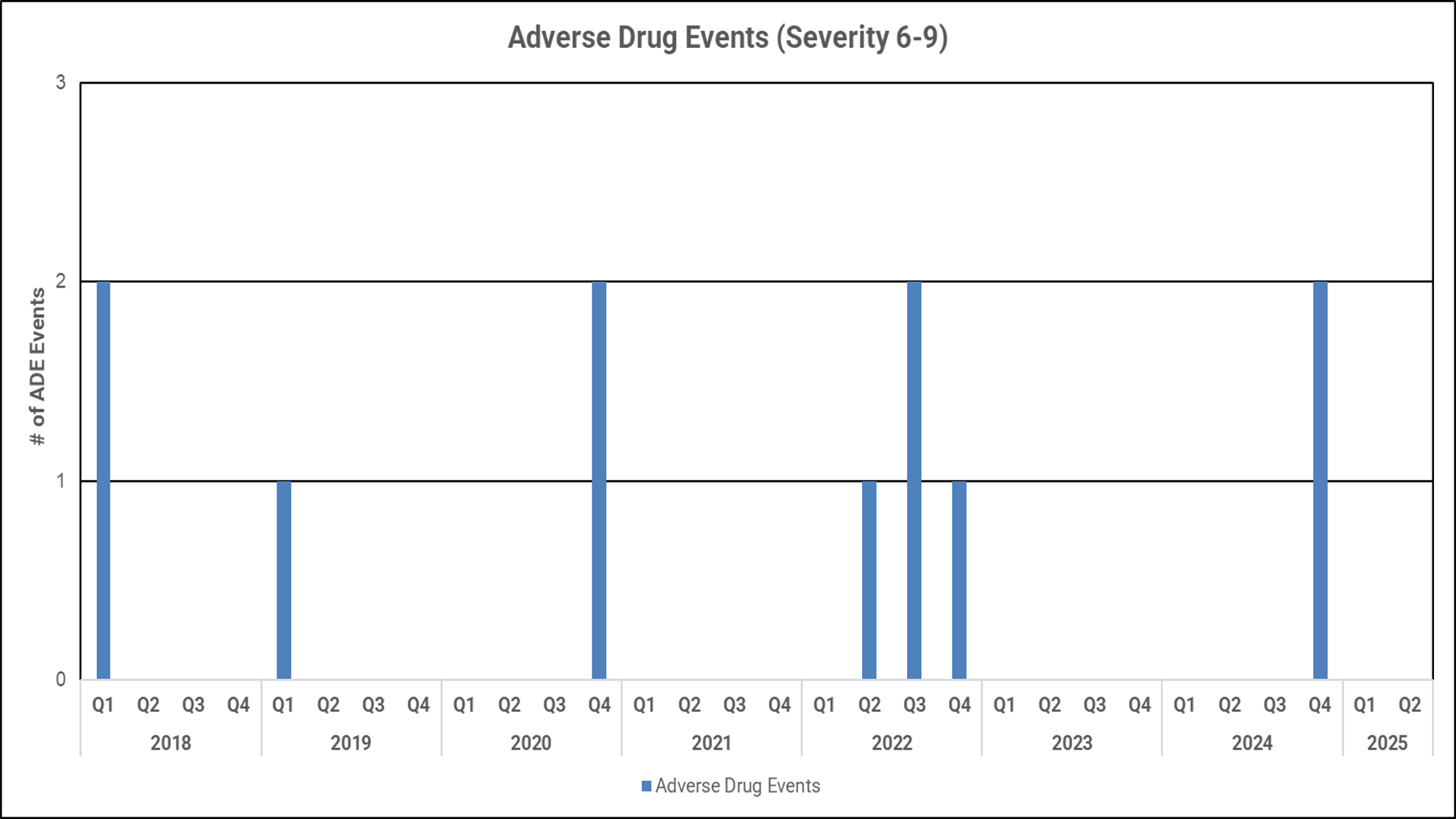
What Are We Doing to Improve?
- We concentrate on providing the right medication, to the right patient, at the right time.
- We have advanced technical processes in place to ensure errors do not occur.
- Feedback is key. We continually provide information and education to our staff about medication errors.
How Can Patients and Families Help?
- Patients and families play an important role in verifying home medications with their medical team to lessen the likelihood of medication errors.
- If you suspect your child is having an adverse reaction to a medication, please immediately let their caregiver know.
What Is the Project and Why Is It Important?
A surgical site infection (SSI) is an issue (complication) resulting from surgery. An infection may develop following any kind of surgery. SSIs can happen when germs get in the surgical wound. We take the prevention of these infections very seriously for many reasons.
- SSIs cause complications in recovery.
- SSIs may cause delayed healing resulting in a longer hospital stay for patients.
- Some SSIs involve the skin only while others are serious and involve the tissues under the skin and organs.
We measure SSIs for surgeries involving the heart, back and brain.
How Are We Doing?
Below is a graph that shows the number of SSIs that have occurred over the last few years.
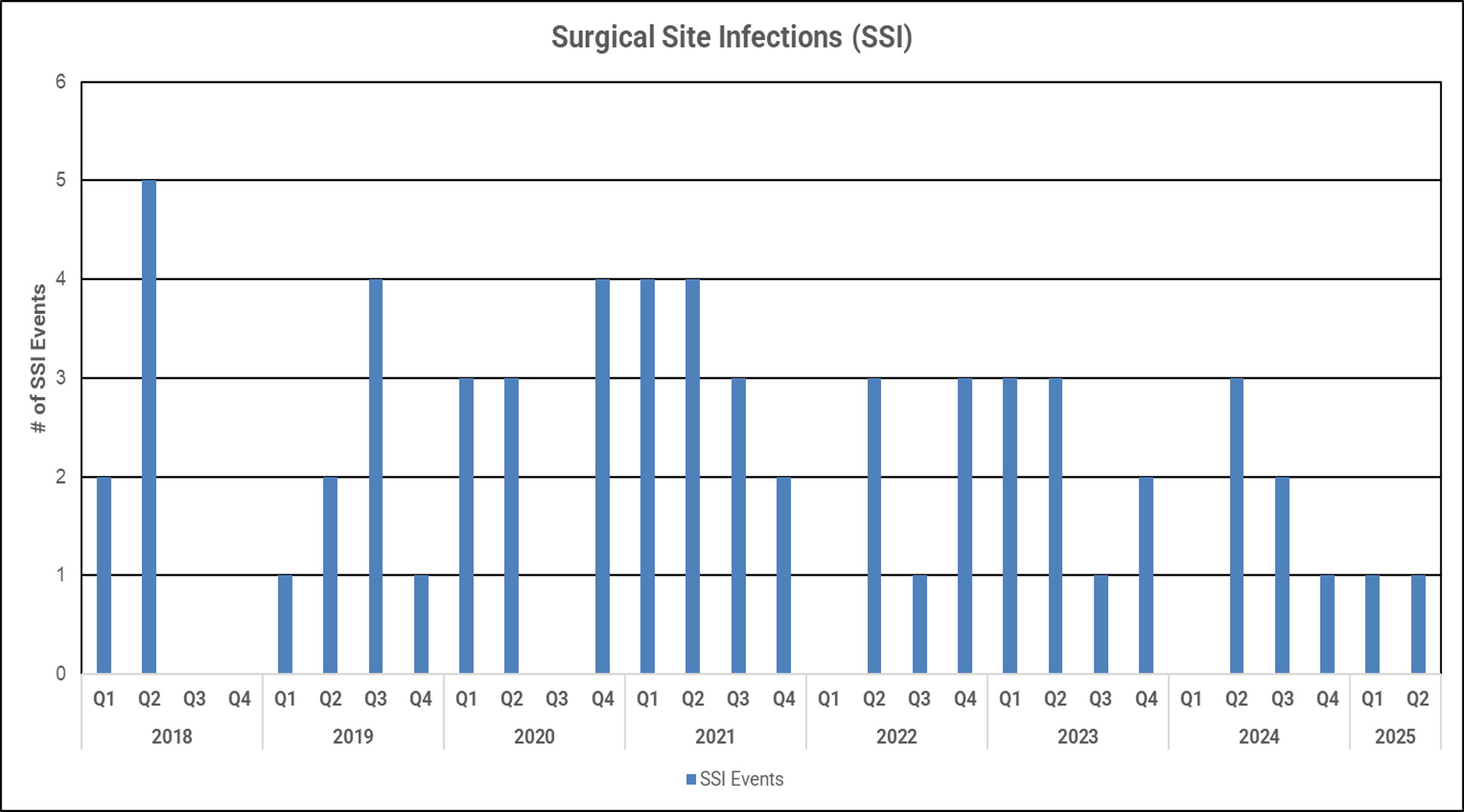
What Are We Doing to Improve?
- We have a detailed prevention program focused on cleanliness and proper antibiotic administration.
- We continuously audit surgery best practices to ensure our staff follows them (compliance).
How Can Patients and Families Help?
- Good hand washing is very important. Washing hands correctly and often is the best way to prevent the spread of germs.
- Do not touch the surgical wound or dressings after your child’s surgery.
- If you see our staff not cleaning their hands before and after caring for your child, please speak up and remind them to wash their hands. Don’t be shy!
- Knowledge is key. Before you go home, make sure you know how to care for your child’s wound. Be sure to ask questions.
What is the project and why is it important?
A central line associated blood stream infection (CLABSI) occurs when germs enter the blood stream through a central line catheter and cause a patient to become sick.
A central line catheter is a small plastic tube that is placed into the blood vessels near the heart. It may be used to deliver important medications, food and other nutrition. It may also be used to draw blood for testing or to monitor blood pressure.
How are we doing?
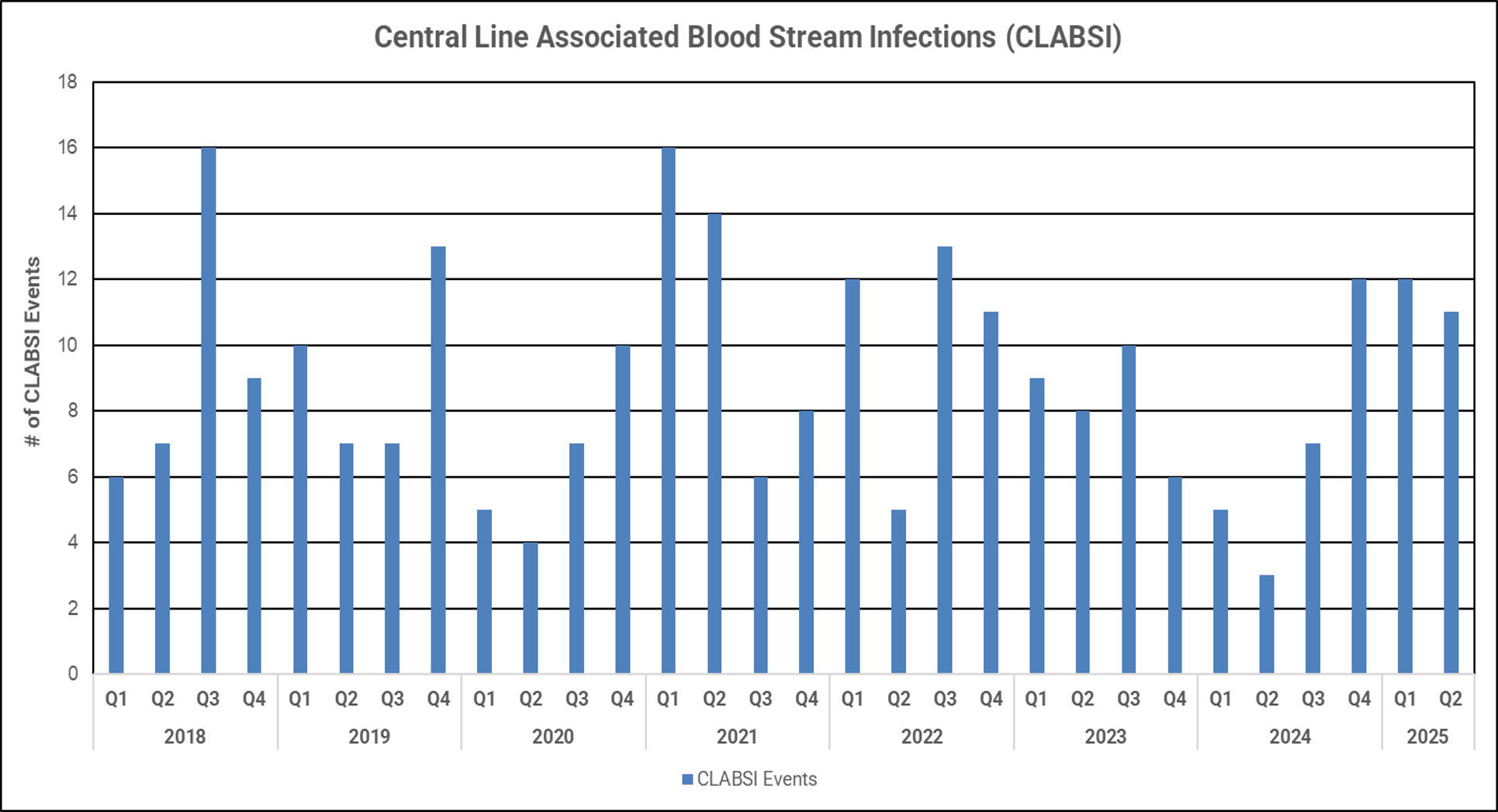
What are we doing to improve?
- We continue to implement the best care practices and investigate and implement new prevention techniques.
- We have dedicated infection prevention champions on each unit who work with staff every day to promote the best care.
- Good hand washing (hygiene) is extremely important to prevent infection. We promote and monitor hand hygiene among our staff.
How can patients and families help?
- Good hand washing is very important. Washing hands correctly and often is the best way to prevent the spread of germs.
- Ensure you do not touch the catheter or tubing while your child has a central line in place.
- If you see our staff not cleaning their hands or wearing gloves prior to using the line, or changing dressings on the line, please speak up and remind them to wash their hands. Don’t be shy!
What Is the Project and Why Is It Important?
A CAUTI is an infection of the urinary tract caused by a tube (urinary catheter) that has been placed to drain urine from the bladder. There are a variety of complications that can occur if a patient has a CAUTI and can contribute to a longer hospital stay. These infections are preventable.
How Are We Doing?
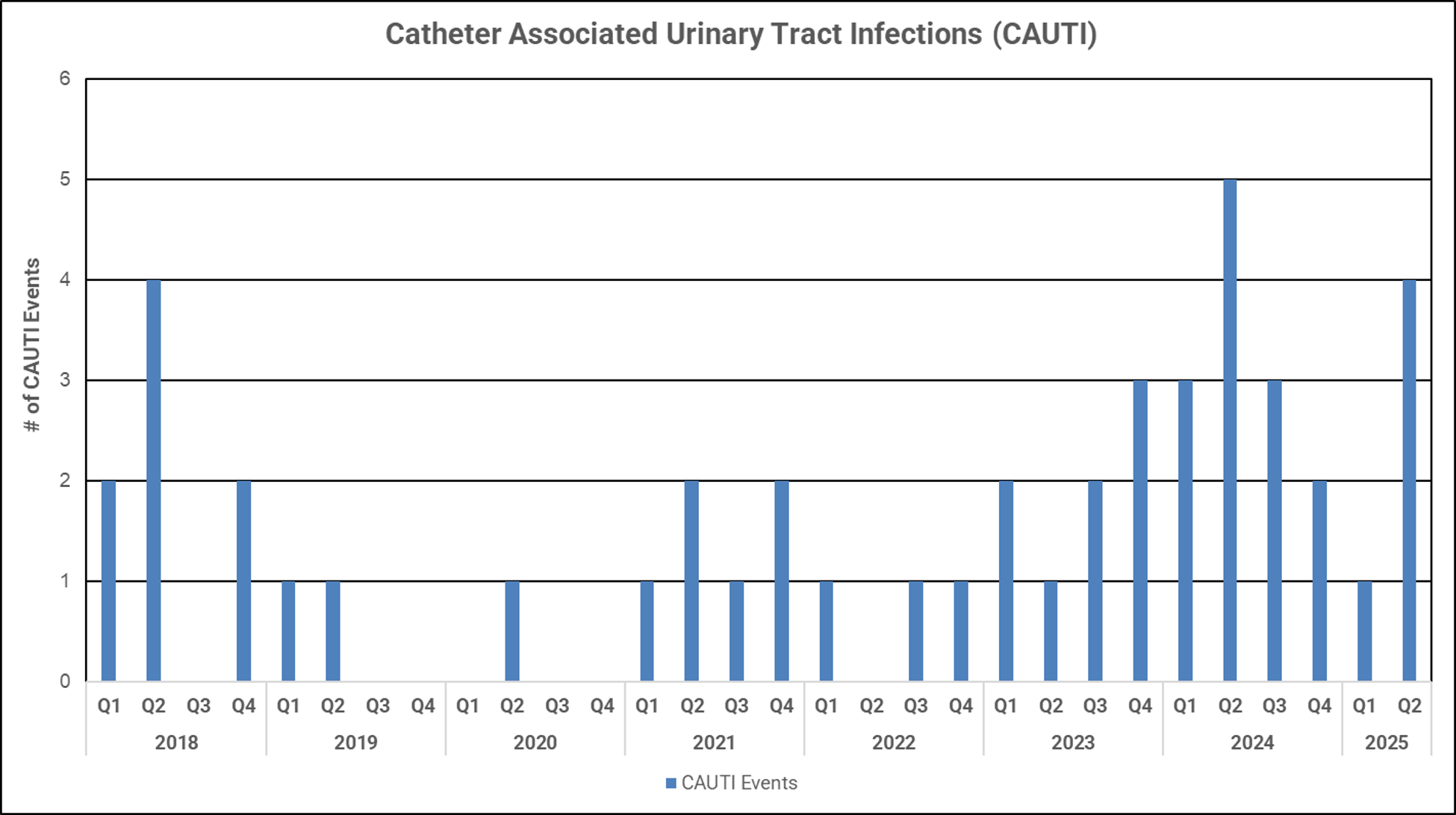
What Are We Doing to Improve?
- We monitor catheter use constantly to ensure that they are in place only if needed.
- We confirm that proper catheter maintenance occurs by regularly checking (auditing) our staff.
- We ensure there is sterile equipment when inserting and maintaining the catheters.
- We promote hand hygiene every day.
How Can Patients and Families Help?
- If you see our staff not cleaning their hands before or after caring for your child, or handling their catheter, please speak up and remind them to wash their hands. Don’t be shy!
Hand Hygiene – a Common Way to Prevent Many Healthcare Acquired Conditions
Hands are the main pathways of spreading germs during health care. Hand hygiene, or hand washing, is therefore a simple, yet very effective way to avoid the spread of harmful germs to prevent health care associated infections. At Nationwide Children's Hospital, we do hand hygiene audits to observe staff cleaning their hands before and after entering a patient’s room and before and after touching the patient and any of their belongings or equipment. Prior to 2021, the audits were not secretive. In 2021, we changed the audit methodology to a blinded audit, meaning staff were not able to tell when they were being observed for hand hygiene audits. We believe the drop in compliance, seen below on the graph of compliance over the past several years, was likely our actual compliance all along. We have reinforced expectations for hand hygiene and focused efforts and strategies to improve compliance with our team in the past two years. We now consistently have compliance between 90-100% and still maintain our blinded audit methodology.
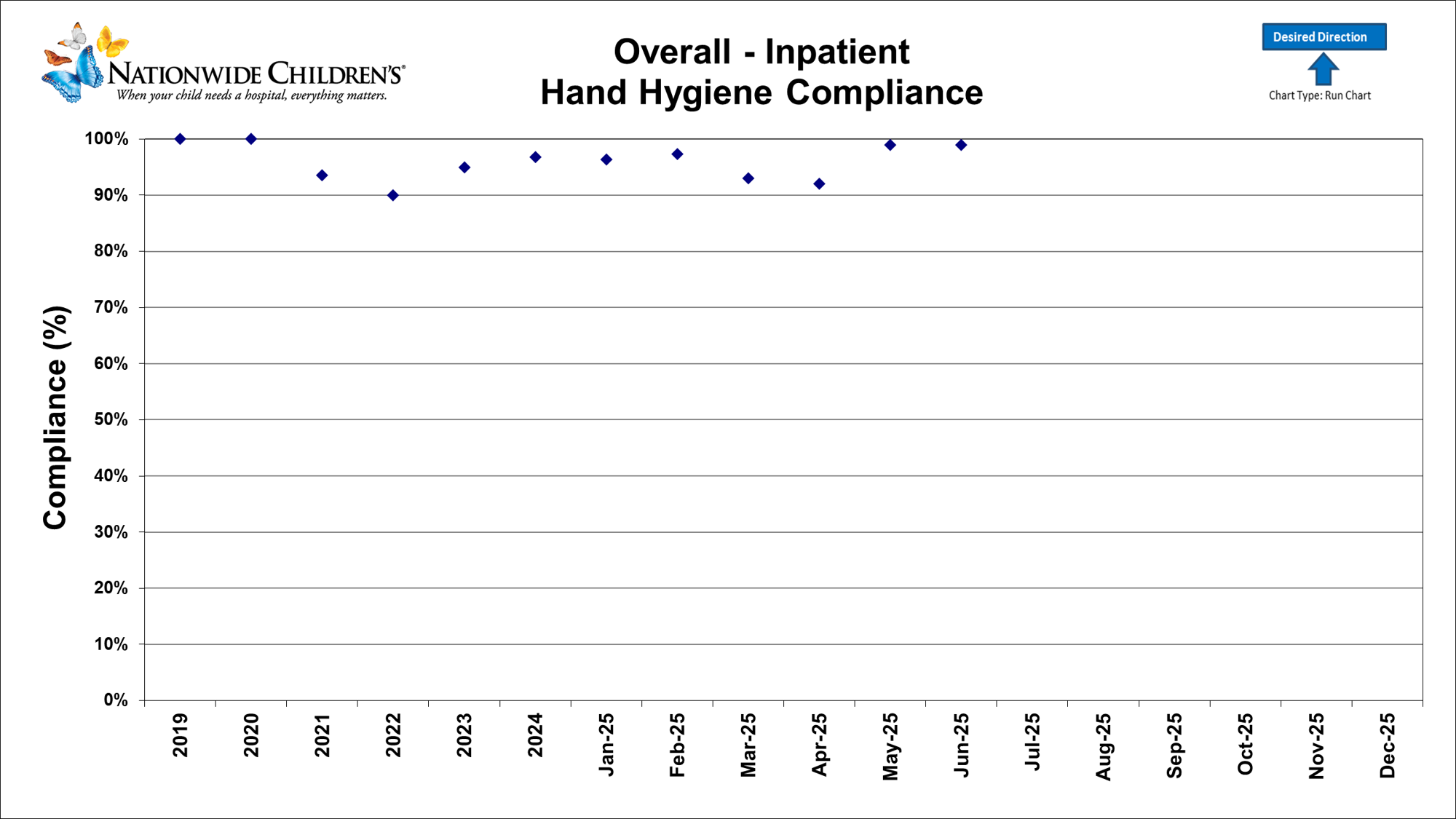
What Is the Project and Why Is it Important?
Some medications can have harmful side effects, like damaging the kidneys, which is called nephrotoxicity. When children are exposed to several of these medications at once or for several days, it can lead to nephrotoxic acute kidney injury (NAKI). NAKI is a common problem in children's hospitals and makes hospital stays longer and more expensive. It can also cause long-term kidney issues. Since 2020, Nationwide Children’s Hospital has had a team working to reduce potential harm and prevent NAKI.
The Pediatric Intensive Care Unit (PICU) is one area where patients are especially at risk for NAKI. Because of this, the PICU quality improvement project team has prioritized NAKI reduction on the unit.
How Are We Doing?
We use two main outcome measures:
- The number of patients who are exposed to several nephrotoxic medications (NTMx) at the same time or for several days
- The rate of acquired acute kidney injury in patients who were exposed to those nephrotoxic medications (NAKI events).
To understand our progress, we look at the number of NTMx exposures and NAKI events per 1,000 patient days in the PICU. Since the project began, we reduced by 41% the average nephrotoxic medications exposures and by 52% the rate of NAKI events.

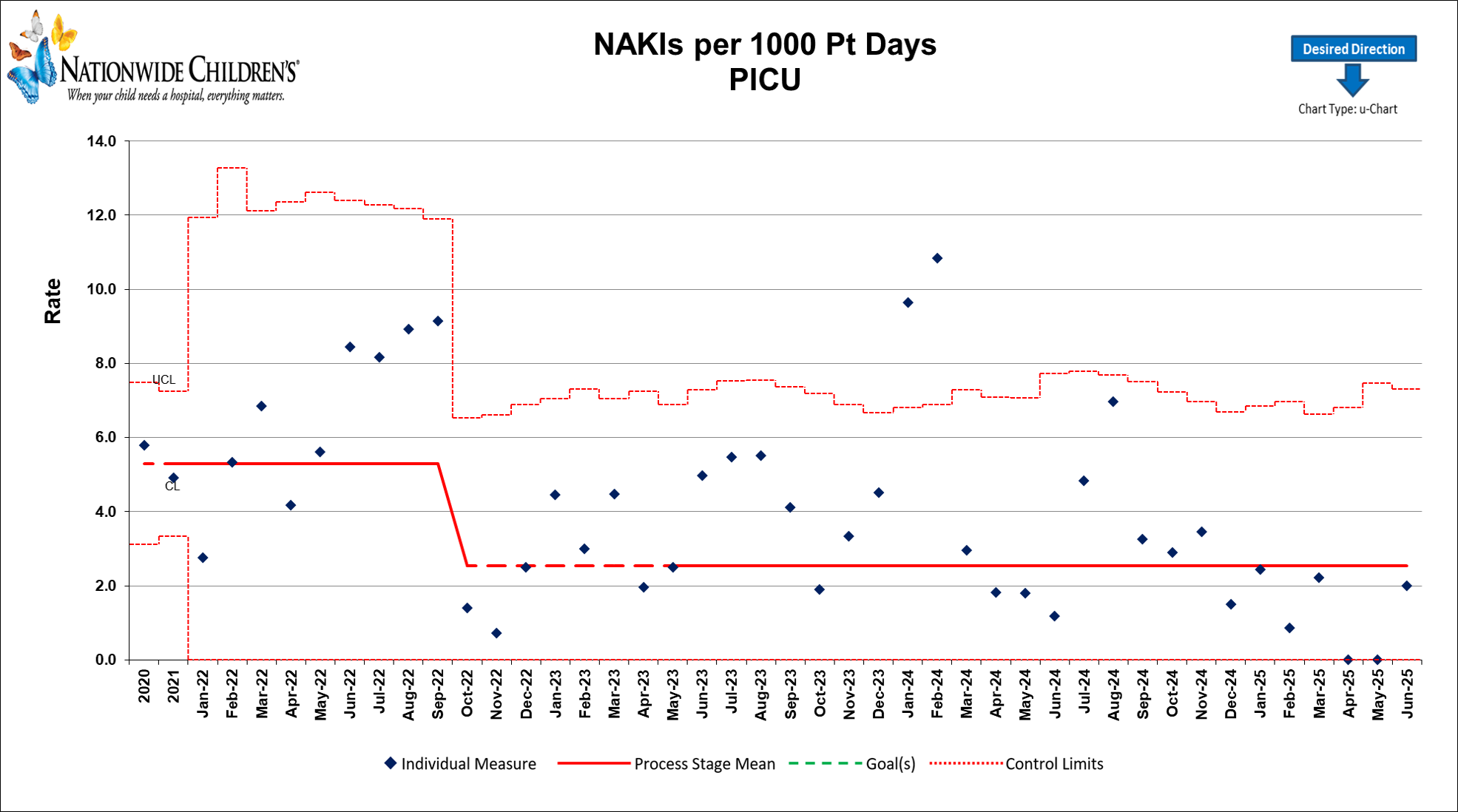
What Are We Doing to Improve?
To reduce NTMx exposures and NAKI events, the hospital and PICU project teams have: focused on:
- Enhancing decision support tools in Nationwide Children’s electronic medical record
- Providing education for providers and pharmacists
- Improving data accessibility
- Identifying unit and service-level champions to drive local improvement efforts
The PICU team worked on enhancing resident physician education and improving communication with attending physicians. Despite the significant improvements, the PICU team remains committed to maintaining a strong focus on NAKI reduction.
How Can Patients and Families Help?
Patients and families play a crucial role in the effort to reduce NAKI. Here are some ways they can help:
- Stay informed: Understand the risks of medications and the importance of monitoring kidney function.
- Ask questions: Ask health care providers about the medications being prescribed, their potential harmful effects and any alternatives.
- Monitor symptoms: Keep an eye on any changes in the patient’s health, such as decreased urine output, swelling or elevated blood pressure. Report these to the health care team immediately.
- Follow care plans: Follow the care plans and medication schedules provided by health care professionals to ensure optimal treatment and monitoring.
- Communicate: Maintain open communication with the health care team. Provide updates on the patient’s condition and any concerns that arise.
By actively participating in the care process, patients and families can help reduce the risk of NAKI and contribute to better health outcomes.
What Is the Project and Why Is it Important?
A pressure injury happens when the skin gets damaged from staying in one position for too long. This often happens in hospitals because patients can't move much or because of medical equipment.
These injuries can become severe. They may require more treatment and result in longer hospital stays.
Patients with traumatic injuries are more likely to get pressure injuries. To help prevent this, Nationwide Children’s started a quality improvement project to reduce these injuries.
How Are We Doing?
In 2021, there were 13 pressure injuries in our trauma patient population. Through the third quarter in 2024, we had five pressure injuries. While we are proud of this progress, we know we must continue the work to protect our trauma patients.

What Are We Doing to Improve?
To prevent pressure injuries, we follow these daily protocols for all patients:
- Keeping patients dry and using appropriate barrier creams.
- Implementing a turning schedule and ensuring proper positioning for at-risk patients.
- Regularly rotating and padding medical devices.
- Consistently using pressure reduction surfaces.
For our trauma patient population, we have additional measures, such as:
- Receiving a consult from a specialized wound care nursing team at ICU admission.
- Using extra padding on devices to prevent injury.
- Getting trauma and burn patients mobile as soon as possible.
How Can Patients and Families Help?
Families and caregivers play a crucial role in reducing pressure injuries. Here’s how they can help:
- Observation: Regularly monitor your child’s skin and inform staff of any concerns.
- Encouragement: If possible, encourage your child to shift their position regularly while in bed.
By working together, we can continue to improve the care and outcomes for our trauma patients.
